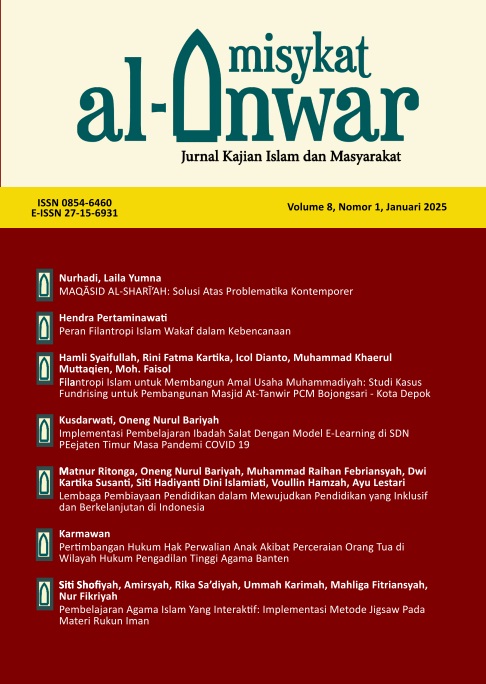PEMBELAJARAN AGAMA ISLAM YANG INTERAKTIF: Implementasi Metode Jigsaw Pada Materi Rukun Iman
Main Article Content
Abstract
Article Details
All manuscripts published in the Misykat al-Anwar Journal of Islamic Studies and Society are entirely the property of the author, as for the entry and unpublished script of the journal, the copyright is wholly the property of the author.
All manuscripts published in the Misykat al-Anwar Journal of Islamic Studies and Society are open to the public by following the provisions of the CC-BY-NC-SA (Attribution Non Commercial Share Alike) platform where everyone is allowed and permitted to adapt, the results of the study with the provision should provide citation credit to the author (citation) not for commercial purposes, and one must make a similar provision to the results of his research.
---
Semua naskah yang diterbitkan dalam Misykat al-Anwar Jurnal Kajian Islam dan Masyarakat sepenuhnya menjadi hak milik penulis, adapun naskah yang masuk dan belum diterbitkan oleh jurnal, hak cipta sepenuhnya milik penulis.
Semua naskah yang diterbitkan dalam Misykat al-Anwar Jurnal Kajian Islam dan Masyarakat terbuka untuk umum (open access) dengan mengikuti ketentuan platform CC-BY-NC-SA (Attribution Non Commercial Share Alike) semua orang diperbolehkan untuk menyadur, merujuk dan mengadaptasi tulisan/hasil penelitian dengan ketentuan harus memberikan kredit rujukan kepada penulis (citation) bukan untuk kepentingan komersial, dan seseorang harus melakukan ketentuan yang serupa terhadap hasil penelitiannya.
References
Arends, Richard I. 1983. “Beginning Teachers as Learners.” Journal of Educational Research 76 (4): 235–42. https://doi.org/10.1080/00220671.1983.10885457.
Arends, Richard I., and Ann Kilcher. 2010. “Teaching for Student Learning: Becoming an Accomplished Teacher.” Teaching for Student Learning: Becoming an Accomplished Teacher, February, 1–427. https://doi.org/10.4324/9780203866771.
Arent, Easy, Emelda Thesalonika, et al. 2023. “Perencanaan Pendidikan.” Surakarta: Tahta Media. http://tahtamedia.co.id/index.php/issj/article/view/227.
Hanafi, Imam, et al. 2023. “Peran Guru Pendidikan Agama Islam dan Sumber Belajar dalam Mengatasi Kesulitan Membaca Al-Quran pada Siswa.” Al Burhan: Jurnal Kajian Ilmu dan Pengembangan Budaya Al-Qur’an. 23 (02), 212-229
Istiqomah, Iis, and Oneng Nurul Bariyah. 2024. “Pola Komunikasi Efektif Guru dengan Wali Santri di Pesantren Tahfizh Daarul Qur’an I’daad Sd Shigor Putri Tangerang.” Misykat Al-Anwar: Jurnal Kajian Islam dan Masyarakat. https://jurnal.umj.ac.id/index.php/MaA16/article/view/20976.
Mardin, Herinda, et al. 2023. “Ragam Model Pembelajaran Inovatif.” Surakarta: Tahta Media http://tahtamedia.co.id/index.php/issj/article/view/677.
Sahara, Siti, Vina Oktaviani, Efri Sandi, Vania Zulfa, Rezi Berliana Yasinta, Rika Sa, Siti Shofiyah, and Ilmi Zajuli Ichsan. 2024. “Graduate Competencies Based on the Aspect of Organizational Activity in Industry 4.0.” IJERE: Int J Eval & Res Educ. 3 (2): 652–62. https://doi.org/10.11591/ijere.v13i2.25803.
Soenarya, Endang. 2000. Pengantar Teori Perencanaan Pendidikan Berdasarkan Pendekatan Sistem. Adicita Karya Nusa.
Johnson, D., & RT, J. (1998). Learning Together And Alone: Cooperative, Competitive and Individualistic Learning (5th Ed). Englewood Cliffs: Prentice Hall.
Sharan, S. (1980). Cooperative learning In Small Groups: Recent Methods and Effects on Achievement, Attitudes, and Ethnic Relations. Review of Educational Research, 50 (2), 241–271
Sharan, Y., & Sharan, S. (1990). Group Investigation Expands Cooperative Learning. Educational Leadership, 47(4), 17–21.
Sharan, Y., & Sharan, S. (1992). Expanding Cooperative learning Through Group Investigation. New York:Teachers College Press.
Slavin. (1995). Cooperative learning. New York: Longman.
Slavin, R. S.-L. (1985). Learning to cooperate, cooperating to learn. New York: Plenum Press.
